Samsung Series 7 NP700Z7C Review
by Jarred Walton on August 16, 2012 2:05 AM ESTInvestigating Samsung Series 7 Thermals and Acoustics
After the fiasco of the Dell XPS 15 launch—frankly, I still can’t believe Dell shipped a laptop that would throttle in every gaming situation I’ve encountered, usually within a couple minutes—we’ve decided to take a detailed look at the temperatures and CPU/GPU clocks on all future laptop reviews. We believe the expectation for some laptop owners is that they should be able to run both the CPU and GPU at a 100% load without dropping clock speeds below the minimum “guaranteed” clocks. That’s pretty demanding, though, and for many users all they really want is for CPU loads to run the CPU at close to maximum turbo clock speeds, while GPU loads (e.g. gaming) will run the GPU at maximum clocks while allowing the CPU to run at lower speeds if necessary—but preferably at least at the base clock of the CPU.
In the case of the 17.3” Series 7, that means the i7-3615QM CPU under load should always run at 2.3GHz or higher and the GT 650M should always run at 745MHz or higher—at least when we’re looking at reasonable conditions where the environment is 80F/27C or below. If the cooling in a laptop can’t reach at least that standard, then the manufacturer should upgrade the cooling or downgrade the components until the cooling proves adequate. With that in mind, let’s take a look at how the Samsung Series 7 handles various loads. We’ll start with the easiest one first: CPU-centric loads (e.g. x264 HD encoding or Cinebench 11.5 SMP in a loop), then we’ll look at what happens with a gaming load (Batman: Arkham City), and we’ll wrap up with a worst-case stress test where we use x264 to encode a 720p video (on cores 2, 3, 4, 5, 6, and 7) while playing Batman: Arkham City (on CPU cores 0 and 1). All of the CPU and GPU clocks and temperatures (and a ton of other elements we aren’t reporting!) are recorded using HWiNFO64.
Last Minute Addendum: Interestingly enough, we conducted the following testing with the original shipping BIOS, but Samsung has an updated BIOS available. We ran the final stress test a second time to see if anything had changed, and it had. Now in our stress test workload, we’re seeing CPU throttling down to a steady 1.2GHz, but the GPU continues to run at 735-835MHz. In other words, Samsung’s BIOS update appears to have gone the opposite direction of Dell’s XPS 15 BIOS releases: Samsung is now throttling the CPU more heavily in order to keep GPU clocks up, where Dell’s latest BIOS is now throttling the GPU to keep CPU clocks up.
Personally, I prefer the CPU throttling, as ThrottleStop is a helpful tool for tuning performance. Also note that CPU throttling when running most games (i.e. no heavy CPU workloads in the background) is generally not a problem with the latest BIOS—only when the system is under a sustained CPU + GPU load have we seen the CPU throttle to 1.2GHz (though of course it’s possible some games will run in such a way that they trigger the CPU throttling). Rather than retesting all areas, we decided to report our initial results as performance outside of the worst-case testing appears to be similar. We’ll update with additional information if we uncover anything more. See below for updated charts.
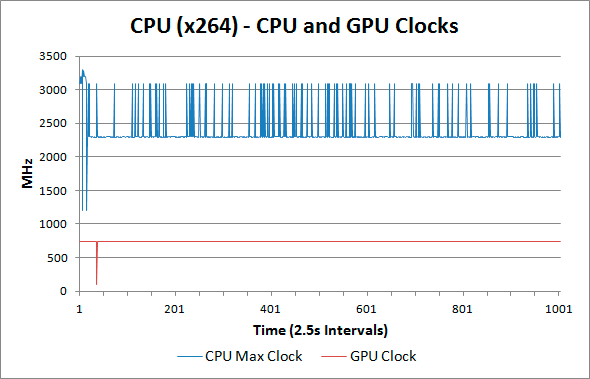
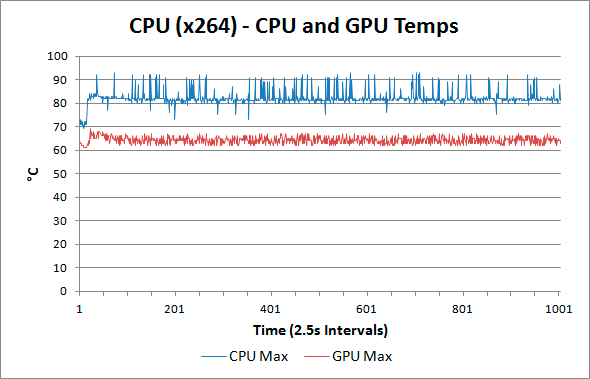
For our tests here, we used x264 HD encoding (for some reason Cinebench kept stealing focus from games and other applications and causing problems on the Samsung notebook, and in general the second x264 encoding pass is quite strenuous). Even with just a CPU load, the Series 7 is already hitting some thermal limits and dropping CPU clocks. What may not be immediately obvious is that the spikes in clock speed up to 3.1GHz match up exactly with the CPU temperature spikes. Basically, the CPU reaches a point where it has enough thermal headroom that Turbo Boost can activate, but then after just a couple seconds (or less) the higher clock speed causes the temperature to jump up 8-12C. While the GPU isn’t really doing anything here, HWiNFO64 apparently keeps it active so that it never clocks down to 93MHz (except for one time early on in the testing). These GPU results are basically our baseline so that we know where the GPU is at when it’s not doing much.
The results here may not be particularly impressive in the grand scheme of things—we’ve seen other notebooks run pretty much constantly at max Turbo Boost without difficulties—but at least everything is working as expected. Users get the “guaranteed” 2.3GHz out of the i7-3615QM, with the potential for the CPU to turbo up to higher clocks under less strenuous workloads. It’s also worth nothing that in a cooler environment (unfortunately, I lack AC so testing was done in an ~80F/27C home—hooray for summer heat!), the notebook should be able to hit turbo frequencies more often. Now let’s see what happens when gaming.
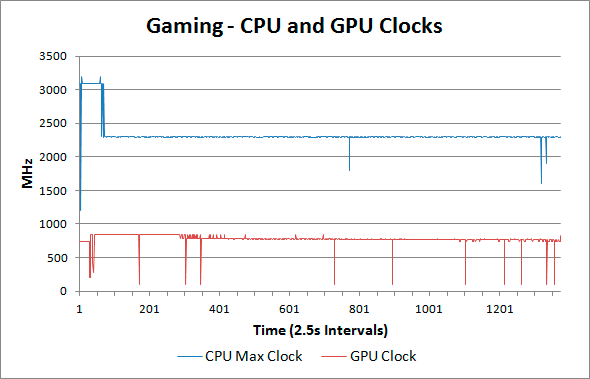
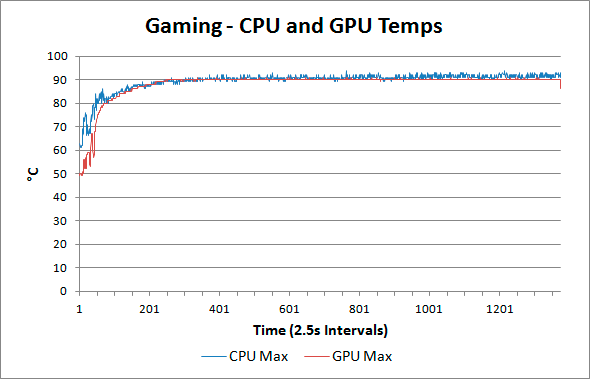
Loading just the CPU wasn’t exceptionally hard on the Series 7, but once we start running games at reasonably complex detail levels (Batman: Arkham City at 1080p Very High in this case) we start to see some additional cracks in the cooling subsystem. CPU clocks are right about where we’d expect: they start at 3.1GHz (and even spike to 3.2GHz a couple times), but after two or three minutes the heat reaches the point where the CPU drops down to the “guaranteed” 2.3GHz (e.g. no Turbo Boost active). There are a few short-lived dips where the CPU clocks dropped to 1.6 to 1.9GHz, but overall the CPU clocks look acceptable. The GPU clocks don’t fare quite as well, unfortunately, and for gaming the dips in GPU clock speed are definitely noticeable.
Most of the time the GT 650M chugs along happily at the rated 745MHz clock speed, and in fact it’s often faster than that—we consistently see GPU clocks of 770MHz and as high as 835MHz. The problem is that we also have 12 dips where the GPU core clock drops way down. The first two (early in the test sequence, most likely during the game’s loading sequence) register 202.5 to 405 MHz, with even the GDDR5 RAM clocking down to 810MHz. Of far more concern are the ten instances during actual game play (we just have Batman sitting idle with a view of the city) when the GPU clock drops all the way to 96-105MHz. That’s less than 14% of the rated clock speed for the GT 650M, and the impact on gaming is immediately apparent—we experienced brief dips into the sub-15 FPS range in practice.
It’s not clear exactly what’s going on, as GPU and CPU temperatures seem to reach a pretty comfortable plateau after 20-30 minutes, but for whatever reason the NVIDIA GPU on occasion will drop down to its minimum clock speed. This may simply be a driver issue, or perhaps Samsung needs to do a bit more fine-tuning of their firmware. Overall, however, the gaming experience is generally good. If you’re a serious multiplayer gamer (e.g. you play at least one game multiple times for an hour or more during the course of a week), or if you’re a competitive gamer (e.g. in a clan or guild of some sort), the gaming experience may be irritating enough that you should look elsewhere. For primarily single player gaming, however, I don’t have a problem with the overall experience. It’s not great, but the GT 650M is fast enough that I could actually live with it as my primary gaming PC in a pinch. (FYI: In practice, 90% of my gaming is still done on a desktop, but much of that is personal preference.)
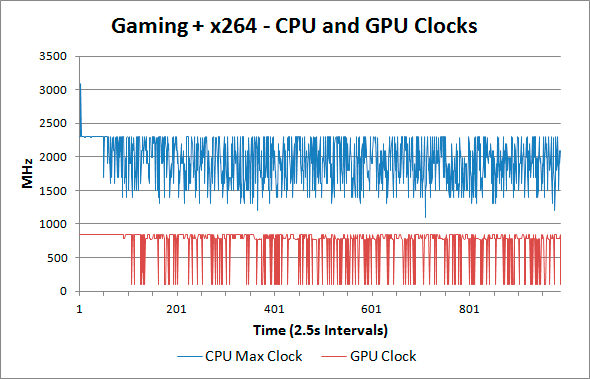
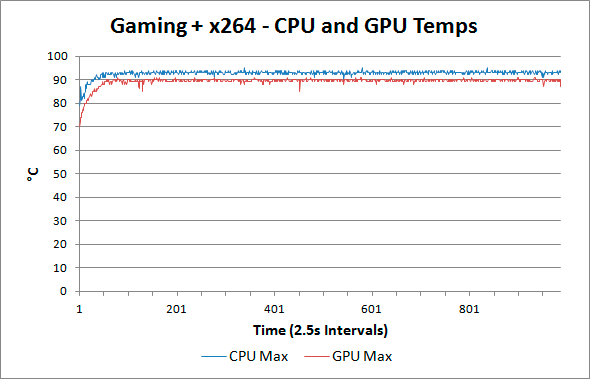
First, keep in mind that our worst-case stress testing is particularly brutal on notebooks. In regular every day use, I have never actually run a workload like this on a notebook. Playing a game is about as demanding as it gets with most notebooks, but we’re presenting these results as a look at how systems cope with 100% loads on all critical components. Also note that long-term, cooling performance tends to degrade as dust builds up, so what starts as a "worst-case" scenario may end up becoming more common in a year or two.
In our worst-case stress testing, just as we experienced with the Dell XPS 15, the wheels start to come off. Dell’s latest A06 BIOS update has come out, we’ve done some initial testing, and it looks like Dell has changed from throttling the CPU to 1.2GHz (unless you use ThrottleStop) to throttling the GPU. Samsung’s Series 7 is a different beast: we get both CPU and GPU throttling when the system is under a truly punishing workload. The CPU clocks drop as low as 1100MHz, with an average clock speed (on the highest clocked core for each sample) of 1947MHz, so clearly the CPU isn’t able to run continually at the rated 2.3GHz. The GPU clocks are all over the place as well, starting out at the maximum Boost Clock of 835MHz for the first few minutes before fluctuating between ~100MHz and 835MHz. The average GPU clock during our 41 minute stress test ends up being 704MHz, but the constant fluctuations are really annoying—Batman would run at 42FPS for a few seconds, then drop to 20FPS, then perhaps settle in at 30FPS for a bit before repeating the sequence.
As for temperatures in our stress testing, both the CPU and GPU seem to hit their maximum sustainable temperatures after just three or four minutes, at which point throttling comes into play to keep the system running. The maximum CPU temperature during our testing was 95C, while the GPU topped out at a slightly cooler 91C. That’s only slightly higher on the CPU than the maximum temperature while gaming, but average temperatures are also higher—we recorded an average CPU temperature of 92.7C (compared to 89.4C while gaming alone) and an average GPU temperature of 89.2C (compared to 88.1C for gaming alone).
The system itself has surface temperatures that are significantly lower than the CPU and GPU core temperatures reported by HWiNFO, and the chassis wasn’t uncomfortably hot. It’s warm certainly, and the rear of the chassis (where the exhaust, CPU, and GPU chips are all located) is quite hot compared to the palm rest and keyboard, but provided you’re not living in a place where the laptop will run in 90F (32C) or higher ambient temperatures you should be okay. I also can’t help but feel the exhaust ports are obstructed by the LCD hinge, which would also increase the likelihood of throttling.
Updated Results for Gaming and CPU+GPU Stress Test with New BIOS
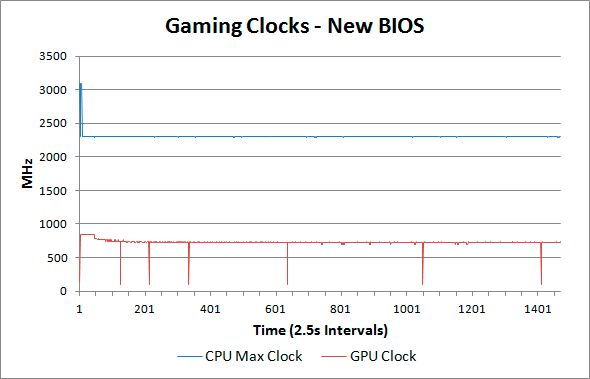

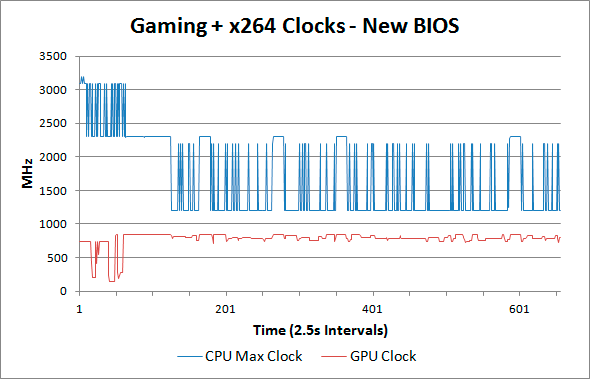
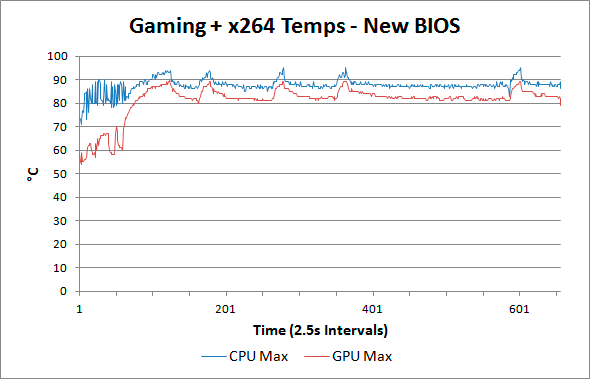
Looking at the gaming and CPU+GPU stress test results with the new BIOS, the only major change is in the stress test where the CPU clocks down to 1.2GHz on a regular basis while the GPU clocks stay closer to the expected range (though they're not always at 745MHz or above). This is generally preferable to throttling the GPU, but most games will suffer a moderate performance penaly from the lowered CPU clocks. ThrottleStop can help in situations like this, where you could shoot for a steady 2.0GHz CPU clock as an example, but given that we didn't see throttling for pure gaming workloads the behavior from the Series 7 is generally acceptable (at least for less demanding users).
Acoustics
Noise levels are decent but not spectacular; I measured a maximum noise level of 43dB under load. I’ve heard substantially louder systems, and honestly I’d rather the Samsung get a bit louder rather than curtailing CPU/GPU clocks. Ideally, we’d want good temperatures and low noise levels, but a quiet system that’s overheating and throttling isn’t desirable. Samsung could easily give up a few dB of noise in order to drop temperatures, and that’s something they should seriously consider if/when they update the BIOS again. At idle, heat and noise aren’t a concern at all, but with a reasonably high-end configuration it’s irrational to expect people to never tax the system.
Ultimately, then, we’re in a similar situation to other thin but potentially powerful laptops: they’re either too thin, too fast, or not built well enough. Perhaps if Samsung had opted for the lower TDP i7-3612QM they would be able to keep thermals in check, or alternately they could use a GT 640M—maybe both. Probably better in the long run would be to use a more potent cooling configuration, even if that means making the notebook slightly thicker and heavier. With the right materials and components, it might be possible to create a thin and fast laptop that doesn't throttle, but doing so without significantly increasing the BoM costs is going to be difficult if not impossible—e.g. look at the $2100 MacBook Pro Retina to see what’s possible (and subtract a couple hundred for the cost of the LCD), and even then the rMBP still appears to throttle under max workloads. If you’re trying to keep pricing in check, however, discretion is simply a better course of action. So basically you can look for laptops that are thin, fast, quiet, and affordable—you can pick any two, possibly even three, but getting all four is basically impossible.










50 Comments
View All Comments
nerd1 - Sunday, August 19, 2012 - link
Exactly WHAT problems? I own 13" MBA and my friend has series 9 2011 model and I think s9 is better in almost all aspects.bennyg - Saturday, August 18, 2012 - link
Where are the comparison with the 95% AUO 1080p TN screens used in Clevo's high end gaming laptopsB156HW01 v4, v7
and the ones used in 17"
Very ironic how AUO and Chimei are responsible for so many cheap crappy low res screens now they're the only ones turning out top notch high res TNs!
rwei - Monday, August 20, 2012 - link
(1) EVEN MORE SHALLOW KEY TRAVEL!!!http://www.engadget.com/2012/08/20/synaptics-enter...
(2) Clickpads with NO BUTTONS AT ALL!!!
http://www.engadget.com/2012/08/20/synaptics-force...
Gonna be some good-@$$ rants coming up in the near future. Bet you're loving Synaptics today.
jsa - Tuesday, August 21, 2012 - link
My 2004 Dell Inspiron 8600 just can't keep up with some fairly basic tasks, so I've been following reviews here (and elsewhere to supplement--wish there were more here!) for the past few months to try to decide on a new machine. The Asus N56V is currently my top contender after being disappointed with the findings in the last couple of reviews.One thing I haven't gotten straight in my head is whether there is some benefit to having the discrete GPU for a nongamer (or occasional gamer at most) such as myself. I understand there may be some battery life disadvantages to having it; are there also some benefits I might reap? Perhaps the whole question is moot as I haven't really seen any interesting options for use as a main computer (not quite ready to relegate the optical drive to my secondary machine), that are limited to integrated graphics.
One thing that seems important to me is having good sound, as I'd like to move around the house and, if I'm going to stay put for a while, listen to music from the notebook without dealing with external speakers; another is a high resolution display, because I like to fit a lot on that screen. The main other contenders seem to be the Series 7 reviewed here, which has a much nicer case and maybe better sound and keyboard, but not as good a screen, much more expensive, and some disappointments in the review; the HP Pavilion dv6, which also seems to have better sound than the N56V, but seems like it may have quality control issues (as well as a glossy screen); the Lenovo Y580, which I don't know much about, but doesn't seem quite as appealing as the N56V; and the Sony Vaio S 15", which generally seems like a good machine, but doesn't seem to have very good sound at all.
Apologies if this isn't appropriate as a comment.
infoilrator - Friday, August 24, 2012 - link
The greatest difficulty is to extend performance, size, cost, and battery life.With speakers more sound is easier with larger speakers. Some of the USB plug ins do pretty well. Being small, light, and power efficient is a contradiction. Piezo tweeters can be loud and efficent if you sacrifice bass. There are dome speakers thar do better, these get expensive fast. Cone speakers are a possible answer, require space and magnets.
Possibly someone makes cordless USB headphones for you, a possible answer.
Every laptop is a marketing/price compromise.
Recently SSD prices have dropped. Please remember lead time in choosing components for mass production. You can have "just in time delivery" but prices and choices can reflect over a year back. Or more. Contracts have to e signed so assembly lines are not idle for want of parts
If prices of HDDs and SSDs continue to fall expect this first to appear with smaller producers.
infoilrator - Friday, August 24, 2012 - link
Around the house maybe a wireless connection to an existing sound system?jsa - Sunday, August 26, 2012 - link
Thanks for all your insights. I don't have an existing sound system, but it may be worth getting rid of the "good sound" requirement, since I won't get great sound, anyway. Then I can either implement a wireless system of some kind or check out USB speakers. (Cordless USB headphones are a pretty interesting option, but don't work when my girlfriend is over.)That opens up my options, and in particular makes the Vaio S 15.5" a more attractive choice.
As someone who wouldn't be playing games much (if ever), is there a strong benefit to losing the dedicated GPU, or is it pretty much a draw?
jemccloskey - Sunday, October 21, 2012 - link
Sorry if I'm posting and this thread is already dead. I have a Samsung Series 7 17" - NP700Z7C-S01US and I am unable to frame rates even close to those mentioned in the benchmark results. I get frame rates between 8-12 @ 1366x768 on Batman Arkham City, Battlefield 3, Fallout: New Vegas. DX11 on and off etc..This is with drivers ranging from 296.87 through all betas and the current released version 306.97. In addition, I have tried every configuration and I have specified to use the nVidia discrete graphics: via context menu, Physx config, and 3D Settings. However, I am unable to pass the 12 fps threshhold. In addition I have installed, the latest BIOS update, Windows7(64bit ultimate and pro) 3 different times, and used Nivdia Optimus GPU Tools state viewer, GPU-Z and Throttlestop 500a.
Just to sum things up: I get better fps average results from using the Intel IGP HD Graphics 4000. And I'm not confusing the nvidia with the intel when profiling. Verified harware ID's, throughput and bandwidth via 3 different utilities.
I have played with all power management issues etc...In any case, I'm totally confused as to how to achieve the frame rates mentioned in your benchmarks. I must be doing something wrong. Any suggestions would be appreciated.
Thank you,
jmccloskey@gmail.com
FlavioJuan - Tuesday, November 13, 2012 - link
I have bought this great Computer a week ago.The GOOD ones
It has a good design is lightweight (4 a 17" Laptop)
Aluminum design is also great looking
Battery last almost the 6 promoted hours,
Bright is OK
Multi touch pad works fine.
Sound is also OK.
Great Battery life extender feature in BIOS.
The BAD ones
For this kind of “high range” computer, I really do not understand why max RAM was designed up to 8Gb.
Battery is not removable (not even a switch to turn it off).
Boot from Pen drive not available in BIOS boot options.
No Blue ray reader.
No button to eject discs from reader, you can eject disc only from windows. (Not even an eject hole) so if you don’t have Windows running… there is no way to take a disc out.
A lot of Samsung proprietary software must be loaded to get this machine full working,
Several features are software dependent, like for example, keyboard backlight, controlled by Fn + F9 F10, so u have to wait till complete windows + driver properly loaded, to have this feature available.
If you are on a non-dark environment then every time you wish the keyboard backlight ON, you will receive a warning telling you that you can just turn in ON only in dark environment.
(In the other hand I tried to disable Light sensor from control Panel >Sensor but it didn’t works. So the solution I have found for this issue was covering the sensor with a coin or piece of tape. Really amazing!)
But what I really hate, (and this seems not only belongs to Samsung laptops, but for most of suppliers) is all the garbage software pre-installed on a new machine.
I buy a new laptop every year, and all I wish is a CLEAN computer installed just with SO + DRV.
I spent almost a day cleaning it in order to get the machine working without all these pre-installed software. Because in this process, sometimes uninstall some vital soft, and as
Re-installing doesn’t works properly, the only solution is perform a complete recovery then start again with the task.
I would prefer my windows 7 working at full range just with my applications instead to waste resources with all the Samsung resident softs that degrades my machine's performance.
But this kind of practice seems to be normal for all the laptop suppliers.
Could we (the customers) do something to change it?
Model NP700Z7C-S03US
SN / HUY691DC800028
Purchased on oct 30 2012 Tiger direct Miami, FL
Best regards for everybody.
Samsung Battery - Saturday, December 9, 2017 - link
If you face any issue regarding Samsung Laptop Battery then feel free to visit.https://laptopbattery.ae/samsung.html